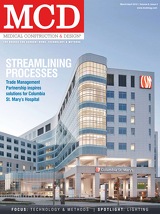Medical Construction & Design (MCD) is the industry's leading source for news and information and reaches all disciplines involved in the healthcare construction and design process. To view more past issues go to: http://mcdmag.epubxpress.com
Page 58 of 70
TECHNOLOGY & METHODS
Less is more with EMR
HOW TRANSITION TO COMPUTERIZED MEDICAL
INFORMATION IMPACTS FACILITIES By DENNIS KAISER, AIA, LEED AP
deaths per year with some 18 percent of those as a result of inadequate medical data about a patient. Computerized medical information, often called
A
"eMedicine," begins with Electronic Medical Records. EMR enables instant input and retrieval of information through a variety of devices — computers, hand-held devices and a micro-chipped health cards the size of a driver's license. It saves time, promotes accuracy and enhances the patient experience, making it the new currency in healthcare here and abroad. Getting there has its challeng-
es for the healthcare industry, including the impact to architec- tural design in ways that support the changes to infrastructure, physical space, the systems needed to ensure operability and allowing human interface to be encouraged and more effi cient.
SHIFTING TO EMR The new federal healthcare law mandates the shift to eMedicine, starting with a fully integrated EMR system. There is incentive
ccurate patient information is a highly criti- cal component of healthcare. Reports cited by the media estimate that medical errors play a part in perhaps as many as 98,000
The future of healthcare, eMedicine will transform hospital environments, on both physical and human levels.
for every healthcare facility, especially hospitals, to adopt it by 2014 — or face lower Medicare reimbursements. However, as recently as 2009 a New England Journal of Medicine study found that less than 2 percent of acute-care hospitals have implemented a fully integrated EMR system and 8 percent have the basics operational. While these systems are taking shape, further
research and development are still needed for meaningful integration of medical data from different sources of knowledge bases and information technologies. In addition, international management standards for data storage, retrieval and security measures to protect patient privacy must be in place to successfully store, update and access patient information successfully.
Physician access to large amounts of patient informa- tion is quickly available by computer, eliminating the need for paper storage.
54 Medical Construction & Design | March/April 2012
EMR CHARTER AND DESIGN PLANNING EMR is not plug-n-play. A fully integrated EMR system incorporates "cloud computing." Under one metaphorical cloud, a number of disparate software applications must communicate with a variety of data centers through a handful of communication protocols
www.mcdmag.com
